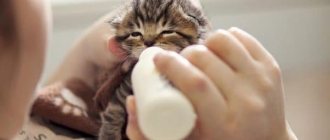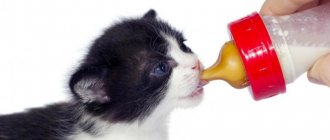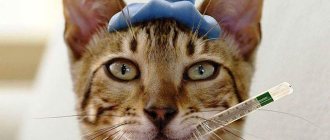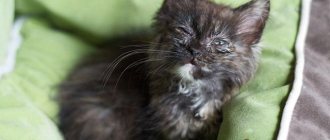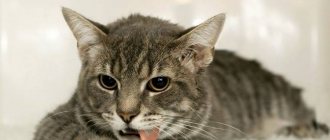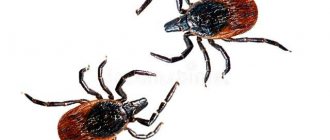feed a newborn kitten for various reasons. In any case, this is a serious responsibility for a small life.
The neonatal period for kittens ends at the age of two weeks. But these first two weeks of life play a decisive role not only in the future health of babies, but also for their very existence. During these two weeks, the kitten adapts to living outside the mother’s body, organs and systems continue to develop, breathing and circulatory processes normalize, the endocrine glands begin to work, changes in metabolism occur, and normal thermoregulation is established. And if during this period the owner is inattentive to the feeding procedure, then in addition to the development of diseases, this can lead to the death of the baby.
How often to feed a newborn kitten
The frequency of feeding kittens abandoned by a cat has long been determined by experts.
Until the fourth day of life, babies are fed every 2 hours around the clock. On the fifth day, the frequency changes: the baby can tolerate it for 3 hours. From the 14th day, only one night feeding is left, daytime feedings are left at the same interval. After 25 days of life, you need to feed 1 time at night; during the day, the interval between meals is 3-4 hours. From the 35th day, a gap of 4 hours is left during the day, and night feeding is removed.
If you have the fate of feeding a newborn kitten in the first days, then do not overfeed the cub: he is given 3-4 ml per feeding. With growth, the interval between meals and the single dose increase.
Preparing a place for keeping kittens
Under normal conditions, the cat independently provides its babies with the optimal temperature regime.
She warms the little kittens who are with her all the time.
Considering that the physiological norm for a cat’s body temperature is 38 degrees, when arranging a place for babies, it is important to take into account that in the nest it should be a little higher.
An electric or simple heating pad is suitable for heating; an infrared heater is perfect.
You can also use plastic bottles with warm water.
Of course, the water in a simple heating pad or bottle will have to be changed frequently.
But this will not be difficult, because small kittens have to be fed several times a day.
This way it will be easy to control the temperature.
It is best to wrap the bottle in a towel or terry cloth.
It is best to cover the nest with soft, non-synthetic fabric or baby diapers, which, unlike fabric, do not need to be washed.
When choosing between a cardboard box and a basin, it is better to choose a basin: a cardboard box can get wet and absorb odors.
Therefore, keeping small kittens in a basin or plastic box will be more hygienic.
carrying bag is also suitable for this purpose .
Houses for cats will also come in handy , only later: caring for orphaned kittens up to one month of age is not entirely convenient in them.
Feeding Basics for Newborn Kittens
If a cat does not feed newborn kittens , then the owner will have to become the mother.
To prevent the process from causing inconvenience, sit down comfortably and place a diaper on your knees. The cub is placed on the prepared bedding - it should lie as if it were being fed by a mother cat. If it is a newborn, then he is placed lying down and his head is raised slightly. It is important to ensure that your head is not thrown back excessively!
After placing the baby, they begin the feeding process itself.
Feeding methods
If you had to replace the furry mother, you need to know how to feed newborn kittens without a cat. First use a pipette or syringe. Although you can find specialized nipples and bottles in pet stores.
A drop of milk is squeezed out of the pipette and the crumbs are brought to the spout. As soon as the baby smells the milky aroma, he begins to look for the nipple. It is at this time that the new “mother” puts a syringe or pipette with milk mixture into his mouth. The main thing is not to swallow a lot of air, which can lead to abdominal pain.
Feeding diet for a newborn kitten
If feeding the kitten falls entirely on the shoulders of a person, then you need to take into account the laboriousness of the process and regularly allocate time for this. If there is no nurse cat nearby who would agree to take other people’s babies under her wing, then you need to think about the most suitable replacement for cat’s mother’s milk.
Together with mother's milk, kittens receive immunity, minerals and vitamins. A suitable mixture can be a replacement. You can buy it at a pet store or prepare it yourself. It is not advisable to heat the mixture in the microwave; it is better to heat it in a water bath until warm. Before giving the cat something to eat, they try to leave a drop of milk on their wrist so that the cub doesn’t get burned. In the first two weeks, the food temperature should correspond to the baby’s body temperature.
At the end of the newborn period, complementary foods consisting of formula and milk porridge begin to be introduced. Starting from day 21, it is useful to diversify the menu with low-fat cottage cheese, baby meat food, egg yolk, fish and lean beef. Starting from day 35, kittens are quite capable of eating from a bowl.
Important points related to feeding
In addition to the daily amount of formula or the frequency of feedings, there are several more nuances of feeding kittens without a cat.
During the first 14 days, attention is paid to the weight of the animal. Veterinarians recommend weighing your pet every day. A kitchen scale is suitable for this. Remember to wipe them with a damp cloth or sponge before and after weighing.
Keep a diary to track your weight gain or loss. If there are sudden changes or a rapid decrease, contact your veterinarian.
The temperature of the mixture you feed the kitten is also important. Adhere to the following standards:
- The first 7 days of life – 38°C.
- From 8 to 14 days of life – 30°C.
- From 15 to 21 days of life – 28°C.
- From 22 to 30 days of life – 24°C.
Make sure your kitten is always warm. Its digestion is to some extent dependent on body temperature. If your baby is cold, food is digested more slowly. In the case of the mixture, this leads to its fermentation, which causes digestive problems.
Your psychological attitude is also important. Stay calm and be patient. Your anxiety will be passed on to your pet. And it is difficult to feed a kitten that is anxious and trying to slip out of your hands.
Some veterinarians recommend introducing vitamins into the diet of bottle-fed animals. They are produced in liquid form. Admission is acceptable from 2 weeks of age of the animal.
How to transition a kitten to solid food
A gradual transition to solid food begins when the pet is 4 weeks old. First, one feeding is replaced with food. Then its share is gradually increased.
To wean the kitten from the formula, he is offered wet food. If the pet does not show interest in it, add one or two tablespoons of the mixture to the food. This will give the food a familiar smell to the animal and make it more liquid and soft.
Make sure your pet always has food in his bowl. This will give him the opportunity to come up and try new food at any time. Which will make weaning from the formula faster.
Veterinarians recommend that the kitten be completely self-feeding by 7 weeks. At the same time, he must eat six times a day.
Preparing a kitten feeding kit
To feed a kitten without a cat, you need to prepare everything you need, so that later it doesn’t turn out that something necessary is missing at that very moment.
First of all, you need to purchase auxiliary devices. You will need:
- plastic pipette;
- disposable syringe with a volume of 20 ml;
- catheter;
- pacifier;
- a small bottle with a narrowed spout (for children or intended for drinking kittens);
- measuring spoon;
- convenient bowl.
It is better to take several different pipettes and nipples at once, as some may not be suitable due to poor quality or may not withstand frequent washing. Syringes should also always be in stock.
If financial resources allow, you can simply purchase a ready-made kit for feeding animals: it includes a plastic bottle with a volume of 35 or 55 ml and a silicone nipple of a suitable size for one-week and two-week-old kittens.
How to determine if a kitten is fed enough
Advice! Both overfeeding and underfeeding are dangerous for both a week-old and a two-week-old kitten. We need to find a middle ground. Underfed kittens are lethargic or restless and do not gain weight. When overfeeding, problems with stool appear.
The main indicator of overfeeding is stool
If it is liquid and yellowish in color, this means that there is slight overfeeding.
With moderate overfeeding, the stool takes on shades of green.
Constant overfeeding is the cause of gray stools.
If the stool turns white, a veterinarian should be consulted to rule out infection.
Feeding with ready-made formulas
If you need to feed a kitten from birth, then you need to know what these babies are fed. Many people wonder whether it is possible to feed newborn kittens with infant formula or whether they will have to buy only specialized ready-made formulas.
If the situation is extreme, and there is baby formula in the house, then it can be diluted in a 1:2 ratio with water. Baby food formulas for the digestive system of kittens are too fatty and rich in micro- and macroelements. Diluted with water in the right proportion, they become less concentrated and heavy for the kitten’s stomach.
Cat milk substitutes have long been developed and sold in veterinary pharmacies. The milk of other animals is less suitable and can easily upset the animal's stomach.
Feeding formulas can be purchased in both liquid and powder form. The digestion of cat babies functions normally, the intestinal microflora is in perfect order.
Milk substitutes and formulas
To feed blind kittens, milk substitutes and formulas are used that are as close in composition to mother's milk as possible. The daily food intake is calculated based on the nutritional value of the milk formula.
The standard calculation scheme looks like this:
- From birth to 7 days – 30 ml per 100 g. body weight.
- From 7 to 14 days – 35 ml per 100 g. body weight.
- From 14 to 21 days – 40 ml per 100 g. body weight.
- From 21 to 28 days – 45–48 ml per 100 g. body weight.
- From day 28 – at least 50–53 ml per 100 g. body weight.
The problem is that for the first two or three days the cat feeds the babies not with milk, but with colostrum, which is rich in antibodies, beneficial bacteria and proteins. By consuming colostrum, babies populate the gastrointestinal tract with beneficial lactobacilli, which help digest milk.
Important! If a kitten is left without maternal care immediately after birth, the chances of its survival directly depend on whether the digestive system can adapt to digesting the unnatural composition of the milk formula.
Industrial cat milk substitutes
Veterinarians say that it is better to use industrial cat milk substitutes for feeding blind kittens:
- Katzenmilch – possible from day one.
- Hartz milk powder.
- Babycat Milk (Royal Canin) - according to the instructions, it is possible only from 2 months, but the mixture can be used earlier if there are no alternatives.
- Beaphar Kitty-Milk.
- Gimpet Cat-Milk.
- Nutri Vet.
- Just Born.
- Nurturall-C.
- Pet Lac.
During the first 14 days of life, kittens' digestive tracts adapt to digesting unnatural food. Afterwards, babies can be switched to baby formula if buying a cat's milk substitute is problematic.
Baby formula
From two weeks of age, you can use infant formula for kittens:
Choose mixtures without sugar or other additives. Infant formula contains less milk sugar (lactose), which makes it easier for the baby to absorb nutrients.
Scott's mixture
If it is not possible to purchase a cat's milk substitute or baby products, you can prepare Scott's formula for kittens at home:
- Homemade, not separated cow's milk – 50 g.
- Powdered milk – 15 gr.
- Dry yeast (nutritional) – 3 gr.
- Chicken egg (yolk and white) – 50 gr.
- Chicken egg white, beaten until foamy – 50 g.
- Sunflower oil, refined – 1 gr.
- Glucose (powder or pharmacy) – 4 g.
Preparation:
- Place all ingredients in a ceramic bowl.
- Mix the mixture thoroughly with a whisk until a homogeneous mass is formed.
- Using a syringe, take out the required amount of the mixture.
- Warm the mixture to 38 degrees before feeding.
The mixture is stored in a refrigerator in a ceramic container covered with cellophane and paper. Shelf life no more than 3 days! The recipe is given for a body weight of 1 kg, so be careful when calculating the daily food intake!
Tiling mix
Another recipe for preparing a cat's milk replacer at home is Tailing's mixture for kittens:
- Homemade, not separated cow's milk – 25 g.
- Powdered milk – 5 gr.
- Glucose (powder or pharmacy) – 2 g.
- Vitamin supplements for kittens (industrial) – 1 g.
Preparation:
- Place all ingredients in a ceramic bowl.
- Mix the mixture thoroughly with a whisk until a homogeneous mass is formed. If vitamin supplements are in tablet form, they need to be crushed into powder. To make the powder dissolve better, you can shake it better in heated milk.
- Using a syringe, take out the required amount of the mixture.
- Warm the mixture to 38 degrees before feeding.
The mixture is stored in a refrigerator in a ceramic container covered with cellophane and paper. Shelf life no more than 3 days!
What natural foods can you feed kittens?
But there are situations in which you have to take care of a newborn kitten yourself. And this is not an easy task. The most difficult thing is to properly feed a kitten . The slightest inattention to the quality of food and the feeding process can lead to poor health, the development of serious diseases and even the death of the pet.
If we are talking about a kitten up to two weeks old, then from natural products rice water, goat milk and condensed milk without sugar are suitable. The first portion should be very small in order to monitor the body's reaction to the new product.
You can also add corn oil, raw egg, and bone meal to the mixture.
If the baby has grown up and the question arises of how to feed a month-old kitten, then the situation here is simpler: cottage cheese, boiled chicken yolk, porridge with meat or milk broth and boiled vegetables are happily kneaded.
Cooking Recipes
Several proven recipes for kittens during the neonatal period:
Recipe No. 1
For 5 parts of 20% condensed milk take 1 part water, 1 tsp. bone meal and 1 liter of milk. All ingredients are mixed until smooth, the liquid is filtered and cooled to 36-38°C.
Recipe No. 2
For a glass of milk take 2 yolks, 1 tsp. vegetable oil, optionally a drop of vitamins.
Recipe No. 3
Food for weakly healthy kittens.
Half a glass of full-fat milk, yolk, 20 ml of glucose 5%, a drop of vitamins.
Strain the mixture and sell within 24 hours. Store the composition in the refrigerator and warm up to 37 °C before use.
Recipe No. 4
All components are taken per 1 kg of kitten weight, you will have to calculate everything correctly.
You need to take 50 g of full-fat milk, 15 g of whole milk powder, 3 g of dry yeast, 1 egg, 50 g of whipped protein, 1 g of vegetable oil, 4 g of glucose. The composition is mixed and heated to 37-38°C
Recipe No. 5
You will need 25 g of cow's milk, 5 g of whole milk powder, 2 g of glucose, 1 g of vitamin supplements.
Recipe No. 6
You need to take a teaspoon each of bone meal and milk, 5 tsp. 20% condensed milk and mix everything.
Recipe No. 7
To 50 g of whole milk powder add the same amount of boiled milk, half a raw yolk and 1 tsp. corn oil.
Recipe No. 8
Take 100 g of milk, yolk, 0.5 tsp. vegetable oil, 20 ml of 5% glucose, a drop of vitamins.
What should you not feed newborn kittens?
If you listen to the advice of experts, ignoring common sense, then it won’t take long for things to get into trouble. There are several “don’ts” in feeding newborn kittens, in addition to a strict feeding schedule, dosage and food intake rules.
Cow's milk is not used in its pure form, as this can lead to severe indigestion and possible death.
No cream, even diluted with water.
Don’t rush and shove sausage or minced meat into your baby’s mouth.
When the baby gets a little older, you also shouldn’t rush to feed him raw freshwater fish, otherwise he may be attacked by helminths.
First supplementary feeding of artificial kittens - when to start
You need to decide when to start supplementing kittens based on the following factors: eye opening, activity, reaction to smells and silhouettes. Active kittens begin to be fed earlier, at about 3 weeks.
Supplemental feeding of artificial kittens can be introduced at an early age, since the digestive system of babies is populated by more aggressive microflora. If diarrhea develops or other alarming symptoms appear, stop feeding. The attempt to introduce supplementary feeding is repeated no earlier than a week after the alarming symptoms have subsided.
What to feed artificial kittens
When choosing what to feed your artificial kitten, give preference to safe, nutritious foods. If the kitten is healthy and active, it is recommended to introduce supplementary food from natural products:
- Whole goat or cow's milk.
- Low-fat broth (beef, rabbit, turkey).
- Boiled minced meat mixed with broth and homemade meat pate.
Caring for a newborn kitten without a cat
Caring for a newborn kitten is not just about feeding it regularly. In addition, full care is required, starting from the moment the umbilical cord connecting the tiny body to the mother was cut. If it so happens that the cat is not nearby, then the babies will need to be provided with warmth and food. It is important to feed the babies earlier - the baby will not die without food for several hours after birth, but there may be problems with the underdevelopment of the sucking reflex, and the digestive functions will not begin to work as they should.
In the nest with kittens, the temperature is maintained at 28-30°C. An excellent choice would be a cardboard box measuring 50 by 50 cm. Up to 14 days - until the eyes begin to open, the box is closed. After this, the lid is not needed, but you should not immediately take the babies into bright light.
If the kittens are not located in the center of the box, but in the corners, it means they are cold, and heating pads with boiling water are placed around the nest.
You also need to regularly inspect and wipe with a linen rag, symbolizing washing by the mother. With such care and attention, future cats will grow up healthy and affectionate.
June 30, 2010 we found two newborn kittens at the entrance. They were in a tied bag and squeaked very loudly. Recently born, not yet licked by the mother cat, with the umbilical cord not yet dried up - apparently, they were taken away from the cat almost immediately after birth and decided to get rid of them in this way.
They took it out of the bag, wrapped it in what was in the bag - in paper napkins, brought it home, quickly washed it in the sink under a tap with warm water, carefully wiped it with an old soft towel and put it in the first thing that came to hand - in a basin, wrapping the kittens in another clean, dry towel, and laying it on an old sweater. They gave them a drop of milk to lick, which was enough for them for the first couple of hours to recover from the stress they had experienced and get some sleep.
Kittens in a basin. First day
I immediately went online and wrote an advertisement looking for a nursing cat, and I found a bunch of articles on how to care for orphan kittens of that age. There were many recommendations. But the basic nursing techniques are:
- Continuous supervision.
- Warmth and cleanliness in the nest.
- Regular feeding.
- Tummy massage combined with hair and eye care.
- Silence and peace for kittens.
Nurse cat or artificial feeding
When deciding how to feed a newborn kitten without a cat, you need to understand that a wet nurse is the ideal solution for both the smallest kitten and its owner.
As a rule, a nursing cat accepts one or more babies easily.
The main thing is to know that the mother and her kittens are healthy and will not infect the babies with infectious diseases, in particular ear mites .
Important! Colostrum, which a cat feeds its kittens in the first two days, is usually not enough. If your kittens are older than those she is nursing, you will need to continue feeding the babies until the nurse begins to produce enough milk.
Continuous supervision
Despite the fact that the kittens move awkwardly for the first few days, they are quite capable of climbing over low sides, climbing either over each other or over crumpled rags, crawl into the most secluded corners of the apartment and hide there. Therefore, I replaced the basin in which I initially put the kittens with a cardboard box with high sides. For the first couple of weeks, a quite suitable den for kittens.
The first days I didn’t make a partition inside the box, but after a week I built it, as the kittens grew older, began to interfere with each other’s sleep, spinning around, looking for the cat, clinging to each other.
Feeding kittens
Over time, there comes a time when it is necessary to begin introducing other foods. Feeding kittens is not recommended until the digestive organs have fully adapted to the substitutes . For abandoned cubs, the transition to a different diet begins a little later than for offspring fed by a cat.
When to start
Factors that influence when to introduce new foods:
- opening the eyes;
- presence of reaction to the outside world;
- pet's mobility.
Feeding usually begins when it reaches three weeks, if the pet is growing and developing quickly. By the age of one month, the intestines are already populated with a sufficient number of beneficial microorganisms.
Warmth and cleanliness in the nest
An absolutely necessary condition for the survival of kittens is warmth in the nest. Usually the cat keeps the kittens warm, leaving the den only for a quick snack and visiting the toilet. I put each kitten in its compartment with an ordinary rubber heating pad. For the first week, the heating pad should always be hot, 37 degrees, we had to change the water even at night, because... By dawn the heating pads had cooled down. Then the temperature gradually decreases, and at the age of one month the heating pad becomes unnecessary. Unless at the dacha, on cold nights, I put hot water bottles on at night.
The heating pad should be wrapped in a separate cloth, since newborn kittens naturally go to the toilet under themselves. And under the heating pad, on top of a soft warm bedding like an old sweater, woolen hat, etc., you need to put a separate rag, preferably on oilcloth, so that it can be changed if necessary. The following figure shows such a socket arrangement. The kittens always huddled close to the heating pad or slept directly on it.
In a box with high sides, with a partition. Kittens are 20 days old
An old sheet will do just fine, tear it into small rags. One or three large sheets are enough for the entire cat’s “infancy”. If you wish, you can wash these rags, but you don’t have to bother and just throw them away. The main thing is that the nest is always dry and clean, and certainly warm. Kittens get cold very quickly, because... Thermoregulation in babies is weak.
I didn’t take the kittens to the veterinarian, I didn’t give any immunoglobulin injections at one month of age, I didn’t use anthelmintics, anti-tick ear or anti-flea medications, but that’s only because the kittens were found in a tied bag immediately after birth. If it were different, then it would be necessary to show the foundlings to a veterinarian, and if there are other animals living at home, then quarantine for the foundlings would be necessary. Well, we got practically “sterile” kittens.
Growth stages and needs of kittens from 0 to 30 days
There are three reasons why you will have to feed orphaned babies:
- Your cat had a difficult time giving birth and required surgery or treatment.
- The young mother's milk did not come.
- You found newborn kittens thrown to certain death and could not pass by.
In the last option, without delay, we do the following manipulations:
- We thoroughly dry the kittens if their fur is wet. We warm the babies with a heating pad or in our hands.
- We examine the face; the kitten should breathe through its nose.
- We check the reflexes, the baby should poke his muzzle into the palm in search of the nipple and try to roll over on his back from stroking his tummy.
- We examine the tummy, the umbilical cord should be short. If the umbilical cord is long and there is a “pouch” at its end, do not panic, this is the kitten’s “place”: Place the baby on a towel with his stomach up.
- Lift the umbilical cord so that all the contents flow into the baby's tummy.
- Cut the umbilical cord with sharp, sterile scissors 1–1.5 cm from the abdomen.
- Treat the umbilical cord and the area around it with green paint.
Important! If you find your newborn has breathing problems—sharp, jerky breathing, wheezing—consult your veterinarian. Kittens lack thermoregulation; when hypothermia occurs, the development of pneumonia is almost immediate, which explains the high mortality rate.
To understand how to feed small kittens without a cat, you need to determine their age and current condition:
- 0–3 days – eyes and ears are tightly closed, the umbilical cord is fresh, they squeak loudly when they feel hungry, weight is 70–90 grams.
- 1–2 weeks – the shape of the eyes is clearly visible, in “early” kittens the eyelids begin to open, the umbilical cord dries out.
- 2-3 weeks - the eyes are open, the ears begin to rise, but the kitten still does not eat on its own, and the baby front teeth are emerging.
- 4 weeks – the kitten walks, tries to play, fangs erupt, and is able to learn to eat on its own.
The first three days are decisive in the life of “orphans”; even with adequate nutrition and care, the likelihood of mortality is high.
Regular feeding
While the kittens were lying in the above-mentioned basin, I found on the Internet that it is necessary to feed the orphans with a special cat's milk substitute, sold in veterinary pharmacies. But 10% cream and regular high-fat milk are also suitable; sometimes you need to add 0.5 liters of raw yolk and 4 teaspoons of granulated sugar. I immediately went to the store.
I used glass pharmacy vials from penicillin as bottles, and the rubber parts of ordinary pharmacy pipettes became the nipples. They calmly stretch onto the wide neck of the bubbles. But you need to immediately purchase about 20 pipettes. They are sometimes torn, sometimes lost, sometimes spoiled by the kittens’ rapidly growing teeth.
The milk needs to be heated, you can do it for 3-5 seconds in the microwave, check before feeding to see if it is too hot - in general, everything is the same as with human children. And, of course, you need to wash and dry the nipple pipettes and bubbles after each feeding. It is convenient to pour the daily portion of milk into a separate jar with a plastic lid, store the jar in the refrigerator, stick a 10 ml syringe with a needle into the lid, and use it to pour milk into the bottle through a hole in the nipple. And you can draw milk from a jar with a syringe without a needle. This is more convenient than aiming milk from a tetra pack or can into a narrow penicillin bottle, then pulling the pipette onto the filled bottle. The syringe and needle should also be washed regularly.
The volume of a kitten's serving increases from 10-20 ml of milk in the first week to 100 ml by 3-4 weeks; they set the frequency of feedings for themselves. By two weeks, the 10 ml penicillin bottle can be replaced with a larger volume bottle, for example, a 20 ml pharmaceutical bottle of bacteriophage, and by three weeks - a 100 ml bottle of alcohol, if the number of kittens is more than one. Kittens eat depending on the weather - sometimes every hour, sometimes every 3-4 hours in sleepy, cloudy weather. When they are full, they lean away from the nipple. At night, our kittens slept decently, giving me a rest from midnight until exactly 8-10 in the morning. Only on the first night they made me stay awake, eating every hour.
It is convenient to feed kittens in your arms, with their back facing you, holding them with one hand under their front legs and belly, and holding the bottle with the other. A hungry kitten will fiercely cling to the bottle, preventing itself from sucking on the nipple, so at the beginning of feeding you need to hold your paws, and then when the kitten is calmly sucking, let go, then he will wrap his paws around the bottle. Visually or on scales, monitor the growth of the babies, by a week the weight should double and reach about 250 g, at 2 weeks - about 400 g, per month about 600-700 g, at 2 months - about 1300 g, by 6-8 months it reaches the size of an adult cat . If the kitten is not gaining weight, is lethargic and weak, go to the vet immediately!
Tummy massage combined with hair and eye care
Under normal conditions, the mother cat licks all the kittens’ fur, eyes, and mouth, thereby not only cleaning them, but also massaging them. Massaging the tummies and perineal area is necessary so that the kitten relaxes and goes to the toilet. Without massage, he does not know how to regulate his muscles.
Orphans can be massaged with a barely damp cloth, and their eyes can be wiped with a damp cotton swab. The kitten itself will begin to wash itself in 20 - 25 days. Our kitten Moor (which we kept for ourselves, and gave the second one away at one and a half months) began to wash itself from the eighth day, and was captured on this day - for history.
The eight-day-old Moor washes his face for the first time.
In the first 2-3 days, the umbilical cord falls off, so during the first days the belly must be wiped especially carefully. The procedure should be done after each kitten wakes up, making them want to defecate. By 4 weeks, kittens can control their urges to go to the toilet, so litter box training can begin at this age. We started even earlier, at about 2 weeks, when the kittens’ eyes had just opened, so that the kittens could get used to the sight of the litter box and to the fact that the smell of the toilet should be located only in one limited place.
When we went to live in the country, we took the tray with us. Once the kittens have woken up, been carried to the litter box and had their tummies and perineal area massaged, and they know that they need to go to the toilet after sleep, the pleasant feeling of relief in the bladder and bowels is automatically remembered and associated with the litter box. In this way, we practically “led” the kittens to the toilet by the hand, so by the age of one and a half months, Moor began to go to the toilet on his own one day. I watched him for a couple of days, no mistakes happened. Of course, then there were a couple of mistakes, but I washed everything with soap, put the lid on with a few drops of vinegar, and Mavrik forgot that place.
Hygiene procedures
In addition to nutrition, you should know other rules for caring for a newborn kitten. After eating, you can massage your cat's tummy clockwise with your fingers or the area under the tail, using a cotton pad soaked in water to empty the intestines.
Cats lick their cubs and try to keep their mouths, eyes, ears, and excretory organs clean. Wipe and wash the cat with warm and damp wipes, dry it so that it does not freeze after the procedures. Wash completely once a day in warm water.
The kitten needs a place to sleep and play at first. To begin with, a deep box is suitable, in which you need to lay soft bedding.
Cover your cat's area with old diapers or cut-up sheets so they can be easily washed or thrown away.
Saucer training, education
The most difficult thing for us was to teach the kittens to lap up milk on their own and eat solid food from a saucer. They loved the bottle. We put small peas of complementary food into their mouths. Why should they give up such pleasure?
In general, kittens, obeying the feeling of hunger, begin to lap at 3-3.5 weeks from the saucer. But with us, they cried shrilly, poked at the saucer, sneezed from milk that got into their noses and could not understand what to do. There was no one to show how to lap; there were no adult cats or dogs nearby. A week of unsuccessful attempts passed, but then guests came to us - experienced cat breeders and in half an hour they taught the kittens to lap from a saucer. You need to dip your finger in the saucer and let the hungry kitten lick it. Gradually reduce the distance from the saucer to the finger until the kitten understands what to do. The first time the Moor was so tired of lapping that he fell asleep with both paws in the saucer.
We just learned to eat from a saucer.
If at 2-3 weeks the kittens are not yet playing, if you take them out of the nest - they can barely walk, waddling from side to side, and constantly squeak, then by 4 weeks they are already accomplished tomboys who have learned to climb onto the sofa, jump on a stool, bite and fight.
Do not allow the kitten to do things that you will not allow him to do as an adult - climb curtains, on the table, sharpen his claws on furniture, scratch his owner. You can teach a nickname at any age, just call the kitten by its nickname, and it will quickly begin to respond to it. Kittens can rumble and purr from the first days, but they will consciously thank their owners for dinner by about three weeks. Talk to the kitten, and he will answer you with purrs, purrs and affection.
Growth stages and needs of kittens from 0 to 30 days
There are three reasons why you will have to feed orphaned babies:
- Your cat had a difficult time giving birth and required surgery or treatment.
- The young mother's milk did not come.
- You found newborn kittens thrown to certain death and could not pass by.
In the last option, without delay, we do the following manipulations:
- We thoroughly dry the kittens if their fur is wet. We warm the babies with a heating pad or in our hands.
- We examine the face; the kitten should breathe through its nose.
- We check the reflexes, the baby should poke his muzzle into the palm in search of the nipple and try to roll over on his back from stroking his tummy.
- We examine the tummy, the umbilical cord should be short. If the umbilical cord is long and there is a “pouch” at its end, do not panic, this is the kitten’s “place”: Place the baby on a towel with his stomach up.
- Lift the umbilical cord so that all the contents flow into the baby's tummy.
- Cut the umbilical cord with sharp, sterile scissors 1–1.5 cm from the abdomen.
- Treat the umbilical cord and the area around it with green paint.
Important! If you find your newborn has breathing problems—sharp, jerky breathing, wheezing—consult your veterinarian. Kittens lack thermoregulation; when hypothermia occurs, the development of pneumonia is almost immediate, which explains the high mortality rate.
To understand how to feed small kittens without a cat, you need to determine their age and current condition:
- 0–3 days – eyes and ears are tightly closed, the umbilical cord is fresh, they squeak loudly when they feel hungry, weight is 70–90 grams.
- 1–2 weeks – the shape of the eyes is clearly visible, in “early” kittens the eyelids begin to open, the umbilical cord dries out.
- 2-3 weeks - the eyes are open, the ears begin to rise, but the kitten still does not eat on its own, and the baby front teeth are emerging.
- 4 weeks – the kitten walks, tries to play, fangs erupt, and is able to learn to eat on its own.
The first three days are decisive in the life of “orphans”; even with adequate nutrition and care, the likelihood of mortality is high.
